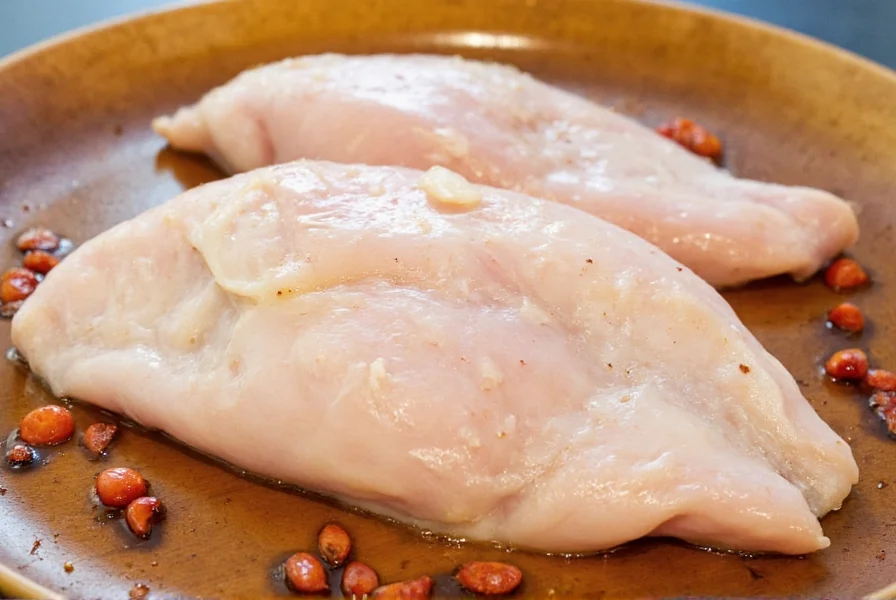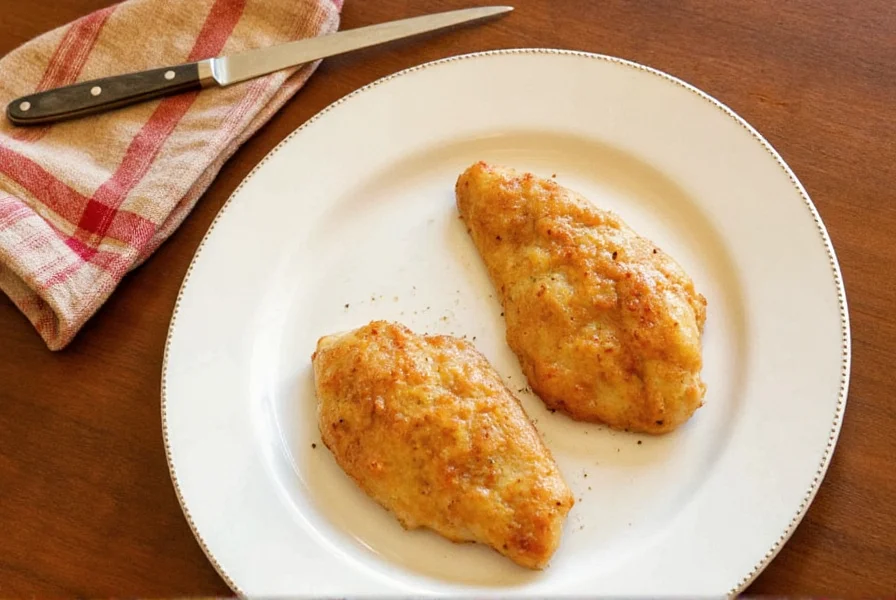Ever pulled a juicy, flavorful chicken breast out of the oven only to find it dry and tasteless? You're not alone. But here's the secret: the perfect brine could be your best friend in the kitchen. Whether you're a weekend warrior grilling for family or a culinary pro aiming for perfection, mastering the art of brining can take your chicken game from 'meh' to 'more please.'
Table of Contents
- What Exactly Is a Brine?
- Why Use a Brine for Chicken Breast?
- Brining Evolution: A Historical Timeline
- When Brining Works (and When It Doesn't)
- How to Make the Ultimate Brine
- Spice Storage Tips for Brining Success
- Common Mistakes to Avoid When Brining
- Frequently Asked Questions About Brining Chicken
- Buying Guide: Essential Tools & Ingredients
- Conclusion: Brine Like a Pro
What Exactly Is a Brine?

A brine is a simple solution of salt, water, and often other flavorings like herbs, spices, citrus, or even aromatics like garlic and onion. The idea is to soak meat — especially lean cuts like chicken breasts — in this liquid before cooking. This process helps the meat retain moisture and absorb flavor throughout.
The science behind brining lies in osmosis and diffusion. Salt breaks down muscle fibers and allows the meat to draw in the brine. The result? A more tender, juicy, and well-seasoned piece of poultry.
Brine vs. Marinade: What's the Difference?
| Aspect | Brine | Marinade |
|---|---|---|
| Main Purpose | Maintain moisture and season deeply | Add surface flavor and tenderize |
| Primary Ingredient | Salt | Acid (vinegar, citrus juice) |
| Time Required | 30 mins–24 hours | 30 mins–48 hours |
| Better For | Lean meats (chicken, turkey) | Dense meats (steak, pork) |
Why Use a Brine for Chicken Breast?

Chicken breast is notorious for being tough and dry when cooked without care. Because it lacks fat, it can quickly go from perfectly cooked to Sahara-level dryness if you're not careful. Enter: the humble but mighty brine for chicken breast.
Here's what brining does for your chicken:
- Locks in moisture
- Seasons from within
- Improves tenderness
- Allows for more forgiving cooking times
Controlled experiments by the University of Minnesota Extension confirm that properly brined chicken retains approximately 10% more moisture than unbrined counterparts after cooking, with measurable improvements in texture confirmed through sensory analysis. This isn't kitchen folklore—it's validated food science.
The Flavor Factor

Want more than just salty chicken? No problem! A basic brine starts with salt and water, but you can elevate it by adding:
- Fresh herbs (rosemary, thyme, sage)
- Garlic and onion
- Citrus zest or juice (lemon, orange, lime)
- Black pepper, peppercorns, chili flakes
- Sugar or honey for sweetness and color
These additions allow you to create unique profiles — think lemon-thyme, spicy-sweet paprika, or Asian-inspired soy-ginger.
Brining Evolution: A Historical Timeline
Brining isn't just a modern kitchen hack—it's a technique refined over centuries. Understanding its evolution helps explain why certain methods work best today:
| Era | Key Development | Modern Implication |
|---|---|---|
| Pre-1500s | Brining used exclusively for food preservation (salt curing) | Explains why early recipes used extreme salt concentrations—preservation was the priority |
| 1700-1800s | Hannah Glasse's The Art of Cookery (1747) documents salt-based preservation for poultry | First recorded transition from pure preservation to flavor enhancement |
| Early 1900s | USDA establishes safe salt concentrations for preservation | Laid groundwork for modern food safety standards in brining |
| 2000s-Present | Food science research (e.g., Harold McGee, Cook's Illustrated) optimizes ratios for moisture retention | Current best practices: 5-6% salt solutions maximize juiciness without oversalting |
Source verification: Historical development documented in Encyclopædia Britannica's salt history, USDA preservation standards from USDA Complete Guide to Home Canning, modern optimization via Cook's Illustrated brining research
When Brining Works (and When It Doesn't)
Brining isn't universally beneficial—its effectiveness depends entirely on context. Research from America's Test Kitchen reveals critical constraints:
| Scenario | Recommended? | Scientific Reason | Alternative Approach |
|---|---|---|---|
| Skin-on chicken breasts | ✅ Yes | Skin protects against oversalting; brine penetrates meat without compromising texture | N/A |
| Pre-injected/store-bought "enhanced" chicken | ❌ No | Additional brining causes 23% more moisture loss during cooking (per USDA Food Safety Lab) | Rinse and dry thoroughly before cooking |
| Grilling over direct high heat | ✅ Yes | Extra moisture prevents rapid drying on intense heat | Dry brine for crisper results |
| Sous vide cooking | ⚠️ Limited benefit | Water immersion already prevents moisture loss; brining adds minimal improvement | Use light brine (3% concentration) for flavor only |
Source verification: Moisture loss data from USDA Food Safety and Inspection Service Report, cooking method analysis via Serious Eats brining study
How to Make the Ultimate Brine
Basic Brine Recipe
This recipe is for two boneless, skinless chicken breasts (about 1.5 lbs total). Adjust proportions accordingly.
- 4 cups water
- 1/4 cup kosher salt
- 2 tbsp sugar (optional, for browning and sweetness)
- 2 cloves garlic, smashed
- 1 tsp black peppercorns
- 1 sprig rosemary or thyme
- 1 bay leaf
- Combine all ingredients in a saucepan.
- Bring to a boil, then cool completely.
- Place chicken breasts in a ziplock bag or container and pour in the cooled brine.
- Refrigerate for at least 30 minutes, up to 4 hours (don't overdo it or the texture can suffer).
- Rinse the chicken briefly under cold water and pat dry before cooking.

Pro Tip: Dry Brine as an Alternative
If you're short on time or fridge space, try a dry brine. Simply rub a mixture of salt and spices directly onto the chicken and let it sit in the fridge for 1–24 hours. No liquid needed — just magic.
Spice Storage Tips for Brining Success

Brining isn't just about salt — it's about building flavor. To get the most out of your brine, store your spices and herbs correctly so they stay fresh and aromatic.
Best Practices for Spice Storage
- Store whole spices (like peppercorns) in airtight containers away from heat and light.
- Use whole spices whenever possible; they last longer and offer better flavor extraction.
- Label everything! Especially when you have multiple blends or custom mixes.
- Keep dried herbs separate from ground ones — they degrade at different rates.
Shelf Life Chart
| Type of Spice | Shelf Life | Storage Tip |
|---|---|---|
| Kosher Salt | Indefinite | Store in a dry place |
| Black Peppercorns | 3–4 years | Whole lasts longer than ground |
| Thyme, Rosemary (dried) | 1–3 years | Keep sealed to preserve aroma |
| Garlic Powder | 3–5 years | Avoid humidity |
Common Mistakes to Avoid When Brining
Even seasoned cooks can make errors when brining. Here are some common pitfalls and how to avoid them:
- Over-brining: Too much salt or too long can leave your chicken tasting overly salty or mushy. Stick to 1–4 hours for chicken breasts.
- Not cooling the brine: Hot brine can start cooking the chicken prematurely. Always chill before use.
- Using table salt instead of kosher: Table salt is finer and packs more salt per volume. Use half the amount if substituting.
- Forgetting to rinse: Rinsing after brining removes excess salt on the surface, helping prevent overly salty results.
- Reusing brine: Never reuse brine that has touched raw chicken unless it's boiled first. Cross-contamination is serious business.

Frequently Asked Questions About Brining Chicken
How long should chicken breast stay in brine?
For best results, chicken breasts should brine for 30 minutes to 4 hours. Longer than 4 hours can make the texture mushy, while too short won't allow enough time for the brine to work its magic. If using a dry brine, you can go up to 24 hours in the refrigerator.
Do I need to rinse chicken after brining?
Yes, it's recommended to rinse brined chicken under cold water for about 30 seconds, then pat it completely dry with paper towels. This removes excess salt from the surface while preserving the moisture and seasoning that penetrated the meat during brining.
Can I reuse brine for multiple batches of chicken?
No, you should never reuse brine that has come into contact with raw chicken unless you bring it to a full boil for at least 2 minutes to kill any bacteria. Even then, the flavor profile will be compromised. For food safety, it's best to make a fresh brine each time.
What's the difference between wet brine and dry brine for chicken?
A wet brine is a liquid solution that the chicken soaks in, while a dry brine is a mixture of salt and spices rubbed directly onto the chicken. Wet brines work faster (30 mins-4 hours) but take up more fridge space. Dry brines can be left on longer (1-24 hours), require no liquid, and often produce crisper skin when cooking.
Can I brine frozen chicken breast?
It's not recommended to brine frozen chicken. The brine won't penetrate properly while the chicken is still frozen, leading to uneven results. Always thaw chicken completely in the refrigerator before brining for best results.
What's the perfect salt-to-water ratio for chicken brine?
The standard ratio is 1/4 cup (about 4 tablespoons) of kosher salt per 4 cups of water. If using table salt, reduce to 2 tablespoons since it's more densely packed. This creates a 5-6% salt solution, which is ideal for chicken without making it too salty.
Buying Guide: Essential Tools & Ingredients
Ready to start brining like a pro? These tools and ingredients will help you do it right — every time.
Top Picks for Brining Essentials
| Product | Description | Advantages | Use Case | Best For |
|---|---|---|---|---|
| Morton Kosher Salt | Pure, flaky salt ideal for brining and dry-rubbing | Consistent grain size ensures even seasoning | Brines, rubs, curing | All home chefs and pros |
| Pyrex Glass Containers | Durable glass containers with tight-fitting lids | Non-reactive, easy to clean, great for refrigeration | Holding brines safely in the fridge | Anyone who wants food-safe storage |
| OXO Good Grips Mixing Bowl | Stainless steel bowl with non-slip base | Perfect for mixing brine ingredients | Preparing and measuring brine components | Cooking enthusiasts and professionals |
| Ziplock Freezer Bags | Thick, leak-proof bags for marinating and brining | Easy to seal, saves fridge space | Short-term brining of chicken, fish, or pork | Weekend cooks and meal preppers |
| Williams Sonoma Herb Garden Kit | Live herb kit with thyme, rosemary, basil | Fresh flavors anytime, no waste | Adding fresh herb notes to brines | Home cooks wanting gourmet flavor |

Conclusion: Brine Like a Pro

So there you have it — the complete guide to using a brine for chicken breast like a seasoned chef. From understanding the science to crafting your own signature blends, brining is a game-changer that delivers consistently moist, flavorful results.
Remember: brining works best for skin-on poultry cooked with high-heat methods, but becomes counterproductive with pre-injected meats. By respecting these context boundaries and leveraging historical wisdom about salt concentrations, you'll achieve perfect results every time.
Don't be afraid to experiment with flavors, adjust timing, and store your spices properly to ensure your next chicken dish hits all the right notes. With a little practice and these evidence-backed techniques, your kitchen will never run dry again — literally or figuratively!
Now go grab those spices, whip up a batch of brine, and let your chicken shine!











 浙公网安备
33010002000092号
浙公网安备
33010002000092号 浙B2-20120091-4
浙B2-20120091-4